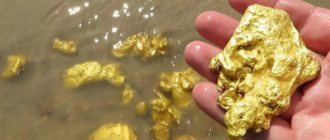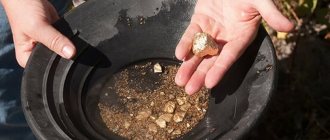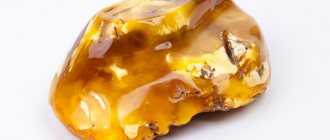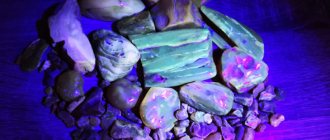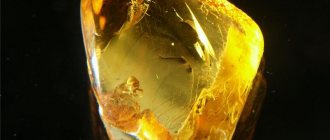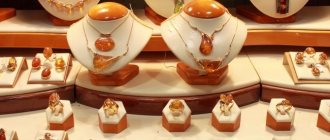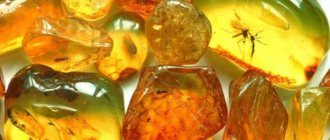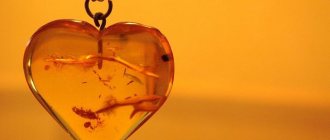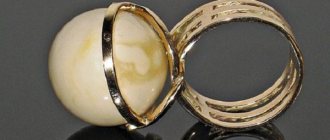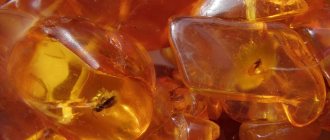I would like to go to the beach in the morning and suddenly see something turning yellow in the surf. Come closer and unearth a huge block of real transparent yellow amber from the sand! Five or six kilograms! That would be great! Do you believe something similar could happen to you? I didn't believe it either. Or rather, I didn’t even think about it. Everything was decided by chance. I really came to the shore of the Baltic Sea and found real amber. Not a huge pile, of course, but there were enough souvenirs for everyone. Do you want me to tell you how it was?
Which one is most valued?
Amber is rightfully considered one of the most popular jewelry and ornamental stones, known to man since ancient times.
White (Royal), green, blue, landscape. It acquired such shades from the influence of external factors. They are rare, so they are considered the most valuable.
How to distinguish real amber and check for authenticity at home (without special equipment)
Real amber or not real - the question is not just complicated, but even baffling. The Kaliningrad region contains more than 90% of the world's amber reserves. There is so much of it here that jewelers do not experience any difficulties in obtaining raw materials. It never occurred to any of them to make fakes and sell them. Firstly, this is reputation, and secondly, the Assay Office constantly monitors and records the craftsmen; no excesses with counterfeit products have been recorded so far.
Usually the untreated side is left in the product. As a rule, it will be negotiable. But this is not always done, because there are beautiful stones that you want to show from all sides.
Related material:
What amber products can be bought in Kaliningrad.
Ultraviolet
If you shine ultraviolet light on it, the amber will glow with a greenish-light green hue. No plastic or any other material will give such a color. By the way, in some cases, miners shine a light underwater to the bottom of the sea; in the sand and natural debris, it immediately becomes clear where it lies.
The directed rays of an ultraviolet lamp give the stone a greenish tint.
Remember, the stone will be heterogeneous in structure, there will always be some kind of picture, bubbles, multi-colored spectra in it. The fake will not turn out as flawless as nature and natural processes came up with.
Pressed amber will also glow, but in normal light it will have a homogeneous structure visible. The stripes will be uniform, the pattern will be the same when pressed. For example, beads from the press are all the same color, with an almost unchanged internal and external pattern. They are homogeneous. The lines run predictably, not chaotically.
Reference. An amber press is cheaper than products made from whole raw materials.
Natural amber balls will look approximately the same color, but if you look at them, you will see that their patterns are different. There may be dark small dots (so-called “pepper”). This indicates that the ball is made from a whole piece.
How to distinguish amber from a fake or artificial stone in a store
There are no fake ambers in Kaliningrad stores, so buy with peace of mind. This is simply not needed by anyone.
At the same time, there are a lot of tips on the Internet for checking authenticity:
- cauterize,
- scratch,
- rub,
- throw into salt water, etc.
How do you imagine this process? Come to the company store with a can of water and a pack of salt. Place it all on the counter. Ask the seller: “Please give me those beads for 50 thousand rubles. I want to check whether they are real or not by dipping them in a salt solution,” or: “Show me a necklace for 35 thousand” - do you take it, scratch it, rub it, and then burn it with a lighter? This is unthinkable!
If you want to buy an expensive amber item, but you don’t understand it and doubt its authenticity, there is a more effective way.
Visit the Amber Museum, where complete information about the stone is presented: from quarry to production. Read about properties, shades, processing. There is plenty of material. You can also ask your questions in the comments under this article.
If you rub regular amber with your finger, it will smell like pine needles. What is considered artificial? I would like to warn some inquisitive people. This is a very soft stone, any attempts at mechanical impact (scratching with a key, rubbing against clothing from buttons and zippers, as well as any type of impact with foreign objects) can cause damage. You should not do this, because you can ruin an expensive product. Such precedents have happened; people paid for a broken product because of their stupidity.
Reference. In 2010, a visitor to the Amber World store decided to check the authenticity of a “Bouquet of Roses” product in the form of a brooch. The buds were made of white amber. The buds flew off as a result of mechanical impacts. The product was damaged, he had to pay for the damaged item.
Keep in mind that brooches and pendants are polished, shaped and processed. How do you imagine testing the product? Scratch something from your pocket? Reading reviews about pressed amber, I want to ask those who wrote this - people, do you know that pressed amber is already more expensive than regular amber in some respects? What could he be more beautiful? What if an ignorant person can’t tell the difference between amber and rosin? Of course, everyone gives out advice.
The main difference between pressed amber and ordinary amber is that pressed amber is the processing of natural stone in special autoclaves, where, under temperature and pressure, a new one is created from it, with certain characteristics necessary for the master to realize the idea. But it still remains amber. In some cases, the pressed one can be more beautiful, at a cost 3-4 times lower than its analogue. This has to do with processing. If usually, in order to obtain a stone with the desired characteristics, you need to process it, spend a lot of effort and money, then with pressing everything is much simpler.
Attention! Do not buy products anywhere, in the backstreets, from random people. Only in stores or workshops. When purchasing a product, you should be given a receipt and consulted on the product, this is exactly the same as in any jewelry store.
It is worth adding that there cannot be artificial amber, only artificial processing of natural stone, which in some cases increases its cost.
Look at inexpensive products in several places, hold them in your hands, take a closer look, study the color scheme. After this, you will understand how to choose what you like. As a rule, there should be no doubt.
All branded stores sell only real products. There can be no fakes there. After all, this is the reputation of a store, craftsman or factory. Each product has its own tag. Products are certified.
Amber mining sites
This mineral is found in different places, but is industrially mined only in places of greatest accumulation. There is a classification that is created taking into account the location of the stone:
1. Baltic. Covers the Kaliningrad region, if we talk about Russia, also the Baltic countries, Poland, Germany, Denmark. 2. Ukrainian. It is mined in the Volyn region. 3. Dominican. It does not rank first in cost, but is unique with blue and green stones.
North America, Austria, Australia, Romania, Spain, France and other countries can also boast of amber. Amber in these deposits will have completely different properties.
How to distinguish amber on the beach from other stones
Distinguishing amber from other stones and glass on the beach is not an easy task. Especially when whole crowds gather around the find and try to gnaw it, sniff it, knock it on their teeth, twirl it, etc. (joke). This is even more difficult to do on a crowded beach.
Amber on the beach of the Baltic Sea.
Of course, it’s lying there and waiting for its lucky owner. By the way, legends about the discovery of large pieces of amber on the shore have been circulating for a long time. They are not unfounded. Emissions occur in various areas of the coast. But on the beach of a resort town, Zelenogradsk, for example, among thousands of vacationers? Hardly. Well, let’s even assume there was an outburst and you found a piece the size of a matchbox. This is incredible, but let's say it. Amber of large fractions will be light, you can look at it in the sunlight - it will glow.
Amber on the beach, washed up after a storm. Please note: small fractions among marine debris.
You can find it after a storm, in inaccessible areas. I’ll even say more, it’s difficult to find a larger nail than the size of your little finger. Sometimes crumbs are thrown onto the shore along with garbage, it’s just a crumb, you can find it if you pay attention to your feet while walking along the beach. But again, the main sign of an amber release will be marine debris, mud, sticks, algae - organic matter in general. This is where you can find small pieces of different shades. It will be yellow, lemon, transparent, rarely cloudy yellowish. This amber is usually collected for crafts and souvenirs.
Transparent amber of flat shape.
How to choose amber jewelry: what to look for
The greater the saturation of the stone and color scheme, the more interesting it is.
Important! A good product will not be cheap. It should be stylish and interesting.
You need to pay attention to the stone. First, in a store or workshop, look at what shades there are and how the product is made. However, the latter will be your choice and taste.
Production of amber jewelry.
Good craftsmen always try to highlight the stone in their work. A special approach and high-quality processing allow us to emphasize the beauty of amber through the means of shape and frame. The goal is not only the final acquisition of profit, but the creation of a work of art that can surprise the buyer. High-quality, unique jewelry is an art.
Hole with a heated awl
At the end of the study, you can try to pierce the product with a heated needle. Amber melts slowly and at the same time emits a pleasant aroma, reminiscent of wood or cloves, while plastic will smell unnatural. The glass will remain unchanged.
There is another counterfeit option, it is called copal. These are pieces of hard resin, they are found on the African coast. Despite its natural origin, heated copal emits a rather unpleasant odor.
How to care for amber
Amber does not like direct sunlight. Therefore, many people store amber jewelry in boxes.
- Do not rub with rough surfaces, as this will cause the stone to lose its shine. It is necessary to avoid mechanical influences, rubbing, wiping at home, attempts to polish, and so on. Only a master can do this.
- Do not use chemicals; they will not add beauty to the stone, but will only worsen it.
- It is necessary to remove products before showering and bathing, avoid contact with perfume, and do not wash in hot water.
All these measures will allow you to preserve the product for a long time in its original form.
How to clean amber beads if they have been lying around for a long time without proper care. How to restore shine?
There is only one recipe - give it to a master for polishing. Do not invent or invent any actions. Only a master knows how to restore the shine to amber.
Can amber beads crack on top?
They cannot unless mechanical influence is exerted on them. Amber is a very delicate stone and must be handled with care. Amber beads should be stored separately from other jewelry.
You won’t be able to clean them from clouding at home - it’s impossible. Some people confuse natural aging with loss of polish. Polishing is just an action on the top or outside of the product. The entire stone ages. This is a natural and normal process.
Look at the structure
Amber is formed over many years from tree resin, so its structure cannot be uniform. Different sides of the stone differ in shades from each other. In addition, natural amber shimmers in the sunlight.
A fake may have unnatural inclusions, for example, sparkles. Such beads will not sparkle in the sun.
Imitation amber has the following characteristics:
- No microinclusions, air bubbles, microcracks. The process of fossilization of resin takes a long time, during which inclusions and air enter the thickness of the material, and displacement of its layers also occurs, leading to internal cracks.
- Absolutely uniform color of a fake or accumulation of paint in one place. Natural resin always has differences in tone with characteristic smooth transitions.
- Too bright or unnatural color. Shades of natural amber range from milky white and honey to dark brown, sometimes with green. Anything outside of this range is likely to be fake.
- Regularly repeating pattern. Drop-shaped air bubbles indicate that the density of the material is low and air is moving outward. Natural amber is characterized by spherical bubbles as evidence of high density.
Beneficial features
Even in ancient times, amber was used as a remedy for many ailments. Various potions using this stone, according to ancient doctors, helped against diseases and ailments.
In Rus' it was believed that if a pregnant woman wears amber, she will safely preserve the fetus, the birth will be easy and the child will be protected from disease.
Chinese sages also wore it. The use of stone dates back hundreds of years.
The Slavs hung amber over the cradle. They believed that this way children sleep better, the stone protects from evil spirits and evil spirits. There is an opinion that it brings good luck.
The medical properties of amber and products in pharmacology have not been fully studied, but many are already used in the manufacture of creams, medicines, and preparations. Science has neither proven nor disproved its beneficial effects on the human body.
Curious cases in Amber production
At the end of the 50s, the Amber Factory sent pressed amber pendants to a trading base in Odessa. Somehow, by chance, amber pendants with inclusions ended up in the batch. These pendants were returned to the plant with the comments “The products are contaminated, do not meet the standards, such products cannot go on sale.”
Amber with inclusions (mosquitoes, midges, moths).
Today, inclusions can be very expensive; some examples on the market fetch from several hundred to several thousand dollars.
